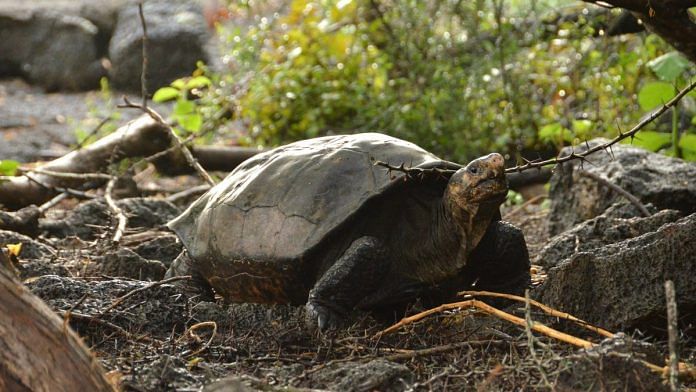Bengaluru: The government of Ecuador released a statement this week that a giant tortoise on the Fernandina Island in the Galápagos, presumed to be extinct since 1906, has been found again.
The animal was discovered by an expedition of the Giant Tortoise Restoration Initiative (GTRI), a project implemented jointly by the Directorate of the Galápagos National Park and the Galápagos Conservancy.
Forrest Galante, host of the Animal Planet show Extinct Or Alive, which looks for creatures thought to be extinct, was with the team when the discovery was made.
Galante, Washington Tapia Aguilera, the leader of the expedition, and Jeffreys Malaga, a Galápagos National Park ranger, are credited as the discoverers.
A Fernandina tortoise, presumed to be extinct since 1906, has been FOUND! She was discovered in an expedition for #ExtinctorAlive by @ForrestGalante. This tortoise was hiding in the brush of a volcano in the Galapagos and was identified by the look of her shell and face. pic.twitter.com/R4a2YOdI8j
— Animal Planet (@AnimalPlanet) February 20, 2019
The rediscovery
Chelonoidis phantasticus, commonly known as the Fernandina Island Giant Tortoise, is part of the ‘Galápagos giant tortoise complex’, a collection of species endemic to the seven islands of the Galápagos.
The species was observed only once, and was represented by only one individual in history — an old male tortoise was written about in 1905-1906, after an expedition from California Academy of Sciences spotted it. The species was thought to be extinct since, as no other individuals were ever sighted on subsequent visits to the island.
“The tortoise was found on Sunday February 17, 2019, in a patch of vegetation in the lower area of Fernandina Island. It is an adult female that possibly exceeds one hundred years. Washington Tapia, director of the GTRI and leader of the expedition indicated that genetic studies will be carried out to reconfirm that the individual found is of the Fernandina Island species,” said the Ecuador government.
The tortoise was moved by boat to the Giant Tortoise Breeding Centre in the nearby island of Santa Cruz, where it will remain in an effort to breed in captivity to conserve the species and repopulate the island.
The expedition team believes there could potentially be more individuals of the species on the island because of evidence of excrement in other areas, separated by lava flows from where this individual was found. The La Cumbre volcano on this island is one of the most active volcanoes today, and is the most active on the geologically new, four-million-year-old Galápagos islands.
In fact, C. phantasticus’ population is thought to have drastically reduced because of frequent volcanic eruptions over the centuries.
Also read: Climate change claims its first mammal, an Aussie rodent ‘not attractive enough to be saved’
Conservation in Galápagos
The Galápagos Islands were declared a UNESCO World Heritage Site in 1978. The name ‘Galápagos’ itself comes from the Spanish word for tortoise, galápago. When Spanish explorers discovered these islands in 1535, there were innumerable tortoises everywhere. Charles Darwin famously visited the islands in the mid-1800s, and the tortoise shells form an important example of evolution in his work.
The tortoises on these islands are some of the world’s longest-living vertebrates. The oldest tortoise on the island was aged 170 years.
Tortoises on the islands vary in shape and size, but invariably started diminishing in population by the second half of the 20th century. Causes for their decline include both loss of habitat due to clearing land for agriculture, as well as capturing and killing for meat. Introduction of non-native species like rats have also threatened local species.
It is believed that due to human activity, tortoises on three different islands have gone completely extinct. Lonesome George, the last individual of the Chelonoidis abingdonii species, died in 2012.
The islands are waking up to the pressing need to conserve tortoises. Conservation efforts have been underway for a few decades, with many juveniles bred in captivity released into the wild to repopulate the island.
Also read: Humans are changing Earth in many different ways at once



